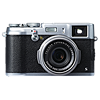Main
Model
Price
Advantages
launch
Announced
Body type
Camera subcategory
Sensor
Effective pixels
Max resolution
Sensor size
Sensor type
Processor
Image ratio w:h
Sensor photo detectors
Other resolutions
Image
ISO
Boosted ISO (minimum)
Boosted ISO (maximum)
White balance presets
Custom white balance
Image stabilization
Uncompressed format
JPEG quality levels
Photography features
Minimum shutter speed
Maximum shutter speed
Aperture priority
Shutter priority
Manual exposure mode
Built-in flash
Flash range
External flash
Flash modes
Continuous drive
Self-timer
Metering modes
Exposure compensation
AE Bracketing
WB Bracketing
Screen / viewfinder
Articulated LCD
Screen size
Screen dots
Touch screen
Screen type
Live view
Viewfinder type
Viewfinder coverage
Viewfinder magnification
Viewfinder resolution
Videography features
Resolutions
File Format
Microphone
Speaker
Optics & Focus
Autofocus
Manual focus
Lens mount
Focal length multiplier
Focal length (equiv.)
Optical zoom
Maximum aperture
Digital zoom
Normal focus range
Macro focus range
Number of focus points
Physical
Weight (inc. batteries)
Dimensions
Environmentally sealed
Battery
Battery details
Battery Life (CIPA)
Storage
Storage types
Connectivity
USB
HDMI
Wireless
Wireless notes
Remote control
Other features
Orientation sensor
Timelapse recording
GPS
GPS notes
Samples
Videos
Summary
The Fujifilm X100S has larger sensor compared to the Fujifilm X-T1: APS-C (23.6 x 15.8 mm) versus APS-C (23.6 x 15.6 mm). This is the most important specification of this camera because large sensor allows the camera owner to capture photos of the more professional quality.
The Fujifilm X-T1 is equipped with tilting display that will allow the camera owner to make great selfies. The Fujifilm X-T1 screen is better as it has more screen dots 1,040,000 in comparison to 460,000 dots of the Fujifilm X100S screen. The higher dot count screen is better for reviewing images on your camera.
The Fujifilm X100S has built-in flash. The Fujifilm X-T1 has built-in Wi-Fi that will help the photographer to transfer photos wirelessly from a camera to a notebook. The Fujifilm X-T1 is weather sealed which means that the camera will be safe even uncovered if you are out shooting in the rain and snow. The Fujifilm X-T1 battery life is better than the Fujifilm X100S battery life. In accordance with CIPA standards the photographer will be able to produce 350 photos with the X-T1 and only 330 with the X100S. The Fujifilm X-T1 weighs 440g that is 5g less in comparison with the weight of the X100S. The Fujifilm X-T1 can utilize optional accessory GPS devices. Recording GPS data can be useful if you like to travel, to be able to go into the picture metadata and see exactly where a photo was captured.
Taking into account the above-mentioned differences the X-T1 will be the best buy. Check the lowest price on Amazon.


